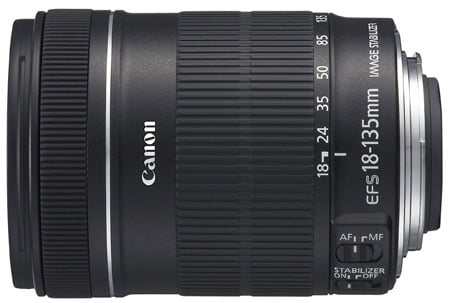
Canon EF-S 18-135mm f3.5-5.6 IS
-
-
Written by Gordon Laing
Canon EF-S 18-135mm IS design, build quality and focusing
The Canon EF-S 18-135mm IS is pictured below, on the far right. In the middle is the up-market EF-S 15-85mm IS USM, and on the far left is the basic EF-S 18-55mm IS kit zoom. From the photo below, the EF-S 18-135mm IS is clearly the longest of the three lenses when each are in their shortest configurations, and looks quite slim alongside the shorter, but stubbier EF-S 15-85mm IS USM.
|
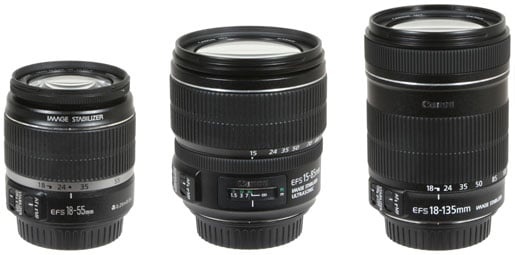 |
Measuring 75x101mm (maximum diameter by shortest length), the EF-S 18-135mm is indeed longer and thinner than the 82x88mm of the EF-S 15-85mm IS USM, although both lenses dwarf the 69x70mm of the compact kit zoom. Certainly if you’re upgrading from the EF-S 18-55mm IS, you’ll find either lens noticeably bigger, but then that applies to almost any zoom on the market.
You’ll also notice a considerable difference in your hands with the EF-S 18-135mm IS weighing-in at 455g compared to the 200g of the EF-S 18-55mm IS. The EF-S 15-85mm IS USM is the heaviest of this particular group at 575g, although the heaviest EF-S lens in the range remains the EF-S 17-55mm f2.8 IS USM which weighs-in at 645g thanks to its constant f2.8 aperture.
When zoomed-in, the EF-S 18-135mm extends by 39mm, compared to 40mm on the EF-S 15-85mm IS USM, although as you’ll see in the photo below, the former employs a single barrel, whereas the latter uses two. There’s minimal play on either design when fully-extended though.
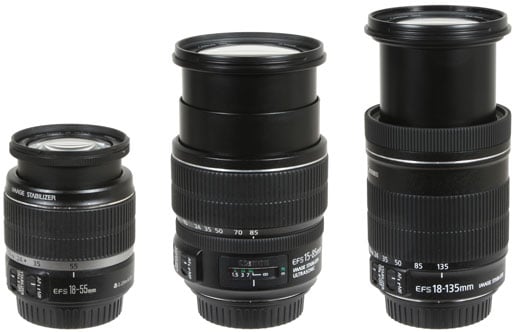 |
In terms of external appearance, the EF-S 18-135mm IS most closely resembles the earlier EF-S 18-200mm IS super-zoom. The latter is only slightly larger at 79x102mm, although noticeably heavier in your hands at 595g. Both models feature wide zoom rings towards their lens mounts and narrower manual focusing rings at the end of their barrels, although neither features a window indicating the focusing distance. For that you’ll need one of the premium models like the EF-S 15-85mm IS USM.
That said, both the EF-S 18-135mm IS and EF-S 15-85mm IS USM share Canon’s latest finish for EF-S lenses with a slightly more textured and less plasticky appearance than earlier models to match its latest EOS bodies – it’s pretty subtle though. More obviously the grey ring indicating focal length on earlier EF-S lenses (as seen on the EF-S 18-55mm IS above) has been swapped for white writing direct on the black barrel. It’s only a minor cosmetic change, but one which looks smarter to us.
The build quality of the EF-S 18-135mm IS roughly matches that of the EF-S 18-200mm IS. Both are fairly solid and well-constructed, while also featuring metal lens mounts. The zoom rings on each model are fairly smooth, although their manual focusing rings are lacking the damping of higher-end models which can make precision work frustrating at times – as we’ll explain in the focusing section below, you’ll also need to disengage the AF motor by switching from AF to MF unless you like the sound and feel of grinding gears.
Ultimately premium models like the EF-S 15-85mm IS USM enjoy an edge in overall build quality, along with a leap in manual focusing precision and convenience thanks to the damping clutch which allows full-time manual focusing. That said, even premium EF-S models like the EF-S 15-85mm IS USM and EF-S 17-55mm IS USM fall well below the build quality of Canon’s ‘L’ luxury lens range. There’s still no environmental sealing on any EF-S model, and their zoom and manual focusing rings can’t match the silky smooth operation of an L model. Then there’s Canon’s continued – and misguided – tradition of only supplying lens hoods with its L-series. Canon does offer lens hoods for the EF-S 18-135mm IS and other EF-S models, but you’ll be paying extra for them as optional accessories.
Finally, like most zooms with longer ranges, the EF-S 18-135mm IS suffers from some degree of ‘creep’, where the barrel can extend or retract under its own weight when pointed directly down or up. On our brand new sample, there was some creep between the 20 and 85mm focal lengths. If the lens was set within this range and pointed directly up or down, the barrel would retract or extend respectively. This is a little annoying, but par for the course for lenses with long ranges or heavy elements – it even affects the pricier EF-S 15-85mm IS USM.
The important point though is when set to 18mm, the barrel will hold position, so you won’t find it suddenly extending when the camera’s in a bag or hanging round your neck or shoulder. Likewise when zoomed beyond 85mm, it’ll also hold in position. It’s also worth noting even between the 20 and 85mm range, you’ll only normally experience creep when the lens is pointing directly up or down; if it’s even slightly angled, it won’t be a problem.
| A quick note about using a popup flash with the EF-S 18-135mm IS. We tried it on the EOS 450D / XSi and EOS 7D bodies and found their built-in flashes managed to clear the lens barrel when zoomed-out, avoiding any shadows at distances above 50cm. Note, the broader 15mm coverage of the 7D’s built-in flash delivers a more uniform result here even at ‘just’ 18mm. |
Canon EF-S 18-135mm IS optical design
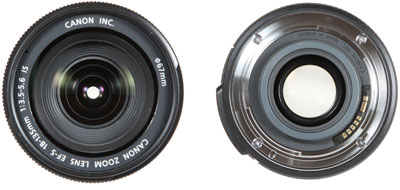 | |
The Canon EF-S 18-135mm IS also shares a number of similarities with the EF-S 18-200mm super-zoom in its internal construction. Both models employ an optical design featuring 16 elements in 12 groups, with six aperture blades and a closest focusing distance of 45cm. Both lenses also share the same f3.5 focal ratio when zoomed-out to 18mm, and the same f5.6 when zoomed-in, although obviously by that point, one is at 135mm and the other at 200mm. The EF-S 18-135mm IS starts operating at f5.6 sooner than the super-zoom though, at around the 60mm focal length. If you’re interested in the potential for out-of-focus effects, check out our Gallery for a sample portrait taken at 135mm f5.6.
According to data supplied by the lens, the maximum apertures operate within the following focal ranges: at f3.5 between 18 and 21mm, at f4.0 between 22 and 30mm, at f4.5 between 31 and 40mm, at f5.0 between 41 and 61mm, and finally at f5.6 between 62 and 135mm.
Canon EF-S 18-135mm IS focusing
Towards the end of the lens barrel you’ll find a manual focusing ring, which feels similar in operation to that on the EF-S 18-200mm IS. Both rotate during autofocus, although this isn’t as big a deal as it sounds as your grip is normally much further back on the zoom ring. At the end of the barrel is a 67mm filter thread, which thankfully remains static during the auto-focus process – good news for users of polarising and other directional filters.
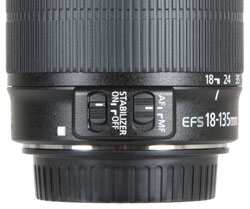 | |
Thanks to the absence of full-time manual focusing though, you’ll need to flick a switch on the side of the barrel from AF to MF before making any adjustments. It is possible to turn the focusing ring while the AF is engaged, but it’s fairly stiff and you’ll feel and hear the motor and gears grinding away which isn’t particularly pleasant nor reassuring for the long-term health of the lens. With the switch set to MF, the focusing ring becomes much looser, although as mentioned earlier, it’s lacking the clutch damping of higher-end models which makes precision work frustrating.
Don’t get us wrong, it’s good enough for most situations, but if you regularly use the magnified view in Live View for fine tweaking, you’ll soon yearn for a lens with superior manual focusing capabilities like the EF-S 15-85mm IS USM, or one of the L-series.
Thanks to the absence of a USM focusing motor, the AF operation of the EF-S 18-135mm IS is also quite audible. It’s not as loud or deliberate-sounding as the EF-S 18-55mm IS kit lens, but there’s still a noticeable sound of motors and gears turning as it auto-focuses. We appreciate the EF-S 18-135mm IS may not be a premium model, but Canon’s own encyclopaedic Lens Work book states the company intends to eventually equip all its lenses with quick and quiet USM focusing motors, so it’s a disappointment not to find one on a new model.
To be fair though, the EF-S 18-135mm IS, like the EF-S 18-200mm IS, can be fairly swift at focusing. The lens can rapidly focus from one end of its range to the other and while it wasn’t quite up to the speed of the USM-equipped EF-S 15-85mm IS USM, we didn’t find any situations where its focusing was insufficiently quick to keep up with moving. You can see and hear a comparison in our Canon EF-S 15-85mm IS USM video tour.
So in terms of speed we have few complaints with the EF-S 18-135mm IS, but every time you hear the gears grind or are prevented from tweaking the manual focus ring without first flicking a switch, you curse Canon for not equipping it with USM.
Now let’s take a look at the coverage and stabilisation in our Canon EF-S 18-135mm IS features page.






